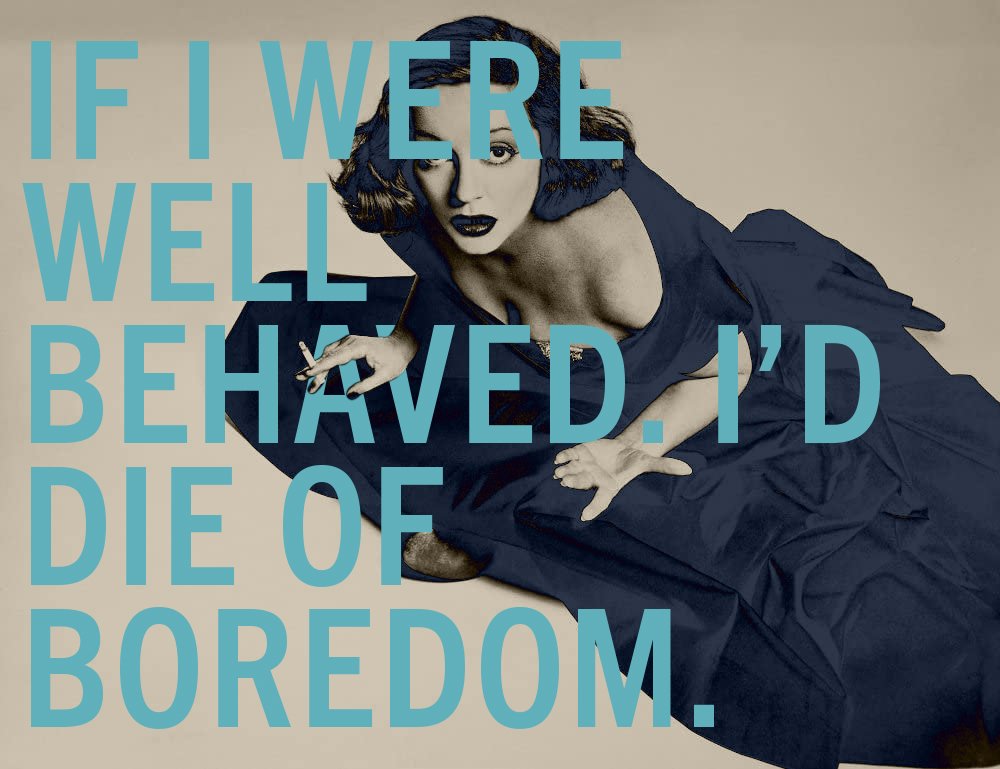Most famous stage actors tactfully fade away. Who today is interested in Katharine Cornell, that First Lady of the American Theatre? Or that other First Lady, Helen Hayes? Or that First among Firsts, Ethel Barrymore? (Well, yes, she was the great-aunt of Drew.) Of the theatrical greats of their day, only Tallulah Bankhead, who died in 1968, has not gone gentle into oblivion. Since her death, there have been seven biographies, the latest, “Tallulah! The Life and Times of a Leading Lady,” by Joel Lobenthal, published only this past fall. And her own book, “Tallulah,” the No. 5 nonfiction best-seller of 1952 (No. 1 was the Revised Standard Version of the Bible; Whittaker Chambers’s “Witness” was No. 9), is recently back in print.
PERSONALITY MORE THAN A STAR
Not many people remember Tallulah’s stage performances, and almost nobody sees her few movies, yet here she is again, hectoring, demanding attention, catastrophically self-destructive; a star more than an actress, a personality more than a star, a celebrity before the phenomenon of celebrity had been identified. How appropriate that her final public appearance was on the “Tonight Show” (where she chatted with Paul McCartney and John Lennon). And what a complicated professional trajectory that suggests, given that her first real success—in London in 1923, forty years before the Beatles—was opposite Sir Gerald du Maurier, then the British theatre’s leading matinée idol. (“Daddy,” his daughter Daphne exclaimed, the first time she encountered Tallulah, “that’s the most beautiful girl I’ve ever seen in my life.”)
Tallulah, with her signature “dah-ling”s and her notorious peccadilloes and her endlessly caricaturized baritonal gurgle of a voice—a voice that the actor-writer Emlyn Williams said was “steeped as deep in sex as the human voice can go without drowning”—would be easy to dismiss as a joke if she hadn’t also been a woman of outsize capacities. As it is, the story of her life reaches beyond gossip and approaches tragedy.
Tragedy, in fact, struck at the beginning. Her twenty-one-year-old mother—“the most beautiful thing that ever lived”—died of complications following Tallulah’s birth, leaving her father, Will, so grief-stricken that he collapsed into a pattern of alcoholism, self-pity, and absence which lasted for years. The Bankheads of Alabama weren’t rich, but they were aristocracy—Will Bankhead’s father and brother were both United States senators—and the motherless Tallulah and her sister, Eugenia, were reared by their grandparents and aunts with strict guidelines (which they ignored) and a strong sense of privilege (which they indulged). Once Will pulled himself together, he went on to become a successful politician, ending as a much admired Speaker of the House under Roosevelt. Tallulah, in turn, was a lifelong passionate Democrat, and took credit—some of it deserved—for helping elect both Truman and Kennedy.
Politics was not the only passion that Tallulah inherited from her father—as a very young man, he had gone to Boston to try his luck as an actor. (He was hauled back home by a no-nonsense letter from his mother.) Even as a little girl, Tallulah was crazy to perform, and frequently when Will, somewhat the worse for drink, drifted home with his pals, he would lift her up onto the dining-room table and have her entertain the boys with risqué songs. She revelled in it. A plump child with startlingly gold hair, Tallulah was an exhibitionist from the beginning.
DENY ME ANYTHING ONLY INFLAMES
MY DESIRE
Another side of her dramatic temperament expressed itself in wild tantrums when she didn’t get her way. (“To deny me anything only inflames my desire.”) She would throw herself down, beat the floor, grow purple in the face, scream bloody murder. Her sister would hide in the closet, but her commonsensical grandmother simply flung a bucket of water in her face.
There were attempts at conventional education for the Bankhead girls. Eugenia, however, eloped in her débutante year with a boy she had met that day. As for Tallulah, at fifteen she convinced her family that she was born to be an actress, and her senatorial grandfather staked her to an assault on Broadway. Chaperoned by her Aunt Louise, she found herself living at the Algonquin Hotel in its early palmy days, and there she encountered the great and the near-great of the theatrical profession, including John Barrymore, who, true to form, tried to seduce her in his dressing room. She had no schooling as an actress and she lacked discipline, but she had vivid charm and looks, and she was absolutely determined to prevail. “I was consumed by a fever to be famous, even infamous,” she wrote.
In her desperation to be noticed, she experimented with alcohol and cocaine, but her main shock tactics involved sex. Apparently, her first affair was with the celebrated actress Eva Le Gallienne, three years her senior, but although she liked to boast about her irregular love life—“I’m a lesbian,” she announced to a stranger at a party. “What do you do?”—she also told a friend, “I could never become a lesbian, because they have no sense of humor!” Perhaps she found later women friends like Billie Holiday funnier than Le Gallienne. On the whole, though, her taste was for men, and early on she met the man she undoubtedly cared for longest and most deeply, “Naps” Alington—Napier George Henry Sturt Alington, the third Alington baron—who was, in the words of Lee Israel, her most perceptive biographer, “a soft-spoken, blond tubercular—well cultivated, bisexual, with sensuous, meaty lips, a distant, antic charm, a history of mysterious disappearances, and a streak of cruelty.”
Tallulah was generally out of funds, scrounging meals and running up bills at the Algonquin, whose long-suffering owner, Frank Case, announced at one point, “I can either run this hotel or look after Tallulah Bankhead. I can’t do both.” Although she was slowly progressing from walk-ons and small parts to leads in undistinguished plays, after some five years in New York the big breakthrough hadn’t come, and she was frustrated, anxious, and broke. When the chance came to play opposite du Maurier in London, she leaped at what she saw as an opportunity to conquer the West End. (Hadn’t a fashionable astrologer told her that her future lay across the Atlantic? “Go if you have to swim.”) The play was called “The Dancers,” and she was Maxine, a Canadian saloon dancer who eventually marries Tony the bartender, who turns out to be the Earl of Chively. With her glorious hair, her unique voice and accent, her unrestrained dancing and cartwheeling (during her English career, she cartwheeled whenever the script allowed, and sometimes when it didn’t), she did indeed conquer the West End.
Throughout the ten-month run of “The Dancers,” a group of rabid young women gathered nightly up in the gallery to express their love for their heroine by screaming, stomping, throwing flowers. Within three years, she had attracted the most loyal—and vociferous—following in London. Observing this phenomenon, Arnold Bennett noted, “Ordinary stars get ‘hands.’ If Tallulah gets a ‘hand’ it is not heard. What is heard is a terrific, wild, passionate, hysterical roar and shriek. Only the phrase of the Psalmist can describe it: ‘God is gone up with a shout.’ ” She informed a reporter from New York, “Over here they like me to ‘Tallulah.’ You know—dance and sing and romp and fluff my hair and play reckless parts.” She had become a verb!
During her London years, Tallulah appeared in sixteen plays, ranging from outright junk (“Conchita,” “The Creaking Chair,” “Mud and Treacle”) to the Pulitzer Prize-winning “They Knew What They Wanted.” She missed playing Sadie Thompson in Somerset Maugham’s “Rain” when Maugham nixed her at the last minute, making her so despondent that she thought she’d give suicide a try, and, according to Lobenthal, “swallowed twenty aspirins, scribbled a suicide note—‘It ain’t goin’ to rain no moh’—and lay down on her intended bier.” The next morning, feeling fine, she was wakened by a phone call begging her to step into a leading role in Noël Coward’s “Fallen Angels.”
A CREATURE OF THE STAGE
Her life in London was hardly restricted to work. She was as famous for her shenanigans offstage as for her flamboyant performances. In her autobiography, she confides, “Have I darkly hinted that for eight years I cut a great swath in London? Well I damned well did, and it was all a spur to my ego, electrifying! London beaux clamored for my company.” Her highly publicized flings extended from the tennis champion Jean Borotra to Lord Birkenhead to a fraudulent Italian aristocrat whom she almost married. And, of course, Napier Alington was always on her mind and often in her bed.
But as the decade drew to a close she decided that it was time to go home: she was approaching thirty, Naps was marrying the daughter of an earl, and she was out of money, since she always spent everything she earned, and then some. And suddenly the way was open to her, via an extraordinary offer from Paramount, beginning at five thousand dollars a week. This was the moment when, with the recent coming of sound, Hollywood was signing up every attractive stage star it could find, and the exotic Tallulah, with her husky seductive voice, could well prove to be the next Garbo, the next Dietrich. “Hollywood for me I’m afraid,” she wrote to her father and, in January, 1931, embarked for New York.
In a year and a half, Bankhead made six feature films (and a lot of money), but none of them really worked. It didn’t matter whether she was leaping off a balcony rather than go back to her blind husband, escaping from a submarine that her crazed husband had sabotaged, or going on the streets to procure money for the medicine needed by her desperately ill husband—reviewers said either that she was wasted on such clichéd vehicles or that she didn’t live up to the better of them. The bottom line is that audiences just didn’t take to her. George Cukor, who directed her once, concluded that she wasn’t naturally photogenic: “On the screen she had beautiful bones, but her eyes were not eyes for movies. They looked somehow hooded and dead.” The reality was that she was first and always a creature of the stage, all about projecting her larger-than-life personality at an audience, never about allowing a camera to explore her face and reveal her feelings. The movies caged and suppressed her. (They did the same thing to another stage phenomenon, Ethel Merman.) Bette Davis, who clearly had benefitted from studying her speech patterns and vocal mannerisms, burned up the screen; Tallulah doused it.
She did, however, have fun in Hollywood, what with her Rolls, her suntan, and her non-stop parties. Joan Crawford reminisced, “We all adored her. We were fascinated by her, but we were scared to death of her, too. . . . She had such authority, as if she ruled the earth, as if she was the first woman on the moon.” There were the usual sexual escapades, including an encounter with Johnny (Tarzan) Weissmuller in the Garden of Allah pool, about which she reported that she had been “a very satisfied Jane.” Yet the biggest scandal she created was a remark she tossed off in an interview: “I haven’t had an affaire for six months. Six months! Too long. . . . i want a man.” This was not the kind of publicity the studios—or the Hays office—could condone, and it helped send her back to Broadway (with her earnings of two hundred thousand dollars).
For half a dozen years, she failed at everything she tried on the stage, most spectacularly in 1937, when she had the calamitous misjudgment to take on “Antony and Cleopatra”: she had no classical technique, and she refused to be coached. The text was butchered, too—in the climactic scene, for instance, the deaths of Cleopatra’s handmaidens were eliminated (“Because, of course, darling, we only want one death in that scene!”). One critic wrote that she was “more a serpent of the Swanee than of the Nile”; another famously quipped, “Tallulah Bankhead barged down the Nile last night as Cleopatra—and sank.”
Also trapped in this disaster was a second-rank actor named John Emery, whom Tallulah had picked up on the summer circuit and, rather casually, married. Emery was good-looking, capable, and amiable. Best of all, he bore a marked resemblance to John Barrymore, and not only in profile: years earlier, when Barrymore revealed himself to her in his dressing room, Tallulah had sworn to herself (and anyone within earshot) never to sleep with any man who wasn’t “hung like Barrymore,” and went on to claim that she had stuck to her word. (Since she also claimed five hundred or more conquests, perhaps she wasn’t always so picky.) One of Tallulah’s party tricks was to escort guests to the master bedroom, fling back the covers from the bed in which Emery was sleeping, and crow, “Did you ever see a prick as big as that before?” So size mattered, but eventually, in his case, not enough. Soon she was telling people, “Well, darling, the weapon may be of admirable proportions, but the shot is indescribably weak.” Within a few years, the marriage, such as it was, was over.
During the thirties, Tallulah had entered the hospital for what was announced as an “abdominal tumor” but was actually a case of gonorrhea—contracted, she was to say, from George Raft—so violent it brought her close to death. It led to a five-hour radical hysterectomy, and by the time she left the hospital she was down to seventy pounds. Undaunted, she announced to her doctor, “Don’t think this has taught me a lesson!” The hysterectomy left her not only psychologically shaky but erotically diminished—again and again, she testified to her lack of physical pleasure, telling Tennessee Williams’s friend Sandy Campbell, for instance, that she couldn’t reach an orgasm with any man she was in love with. (She gave as an example the multimillionaire Jock Whitney.) Louise Brooks reported to Kenneth Tynan, “I always guessed that she wasn’t as interested in bed as everyone thought.” Apparently, Tallulah cared more about the act of conquest than about the sexual act itself.
UNRESTRAINED EXHIBITIONISM
Another aspect of her pathology was her unrestrained exhibitionism. She was famous for throwing off her clothes at parties, for leaving her bathroom door open, for working without panties on. When she was performing in Thornton Wilder’s “The Skin of Our Teeth,” so many people in the audience complained that Actors’ Equity had to order her to wear underpants onstage. When she was making “Lifeboat,” Alfred Hitchcock, as Lobenthal puts it, fielded complaints “with his much-quoted deliberation about whether the matter needed to be referred to the makeup or the hairdressing department.
In the late thirties, after the failure of her vigorous campaign to secure the role of Scarlett in “Gone with the Wind,” her luck changed. Her commanding performance in Lillian Hellman’s “The Little Foxes,” as a malevolent Southern matron who stands by coldly while her husband dies, riveted Broadway. A month after the opening, in March, 1939, she was on the cover of Life, and the text of the accompanying story was unambiguous: “Somehow it seemed impossible to find adequate parts for this strange electric woman with the languid eyes, the panther’s step and the siren’s husky voice. But now . . . she fills, for the first time, a role carved big and fierce enough for her talent.” Her triumph was unalloyed, except for the fury and chagrin she felt at losing the film version to Bette Davis.
Late in 1942, she opened in the allegorical “Skin of Our Teeth,” playing the immortal temptress Sabina in the various guises of housemaid, beauty-contest winner, and camp follower. This demanding role gave her a chance to display her rollicking humor and her allure and gave her a second Broadway triumph. And soon she was playing a famous journalist in that claustrophobic wartime drama “Lifeboat.” “It was the most oblique, incongruous bit of casting I could think of,” Hitchcock later said. “Isn’t a lifeboat in the middle of the Atlantic the last place one would expect Tallulah?” Yes. But she carried it off (if somewhat heavily), and was rewarded by the New York Film Critics Circle, which named her the Best Actress of 1944. There was only one more important film, a year later—“A Royal Scandal,” which sank under the weight of Otto Preminger’s direction and her own somewhat labored performance as Catherine the Great.
These years that established her as a major force on Broadway also saw the development of Tallulah’s serious interest in politics and world affairs. At the time of Dunkirk, she swore not to have another drink until the Allies were back in Paris, and she more or less kept her word. On the home front, she campaigned for every Democrat in sight and helped her friend Eleanor Roosevelt set up the Washington branch of the Stage Door Canteen. In the early fifties, at the height of Joseph McCarthy’s influence, she pulled no punches about her loathing of him: “I think Senator McCarthy of Wisconsin is a disgrace to the nation.” She was also a passionate anti-Communist.
From the start, her political mentor had been her father—he died in 1940—but although she always claimed that he was the most important figure in her life, the reality is that they never were comfortable with each other and spent almost no time together. Lobenthal is convincing when he says that the “paper trail records her attempts to put definite boundaries around their relationship. . . . Yet when she did write, her invariable recitation of only good news also tells us how much she sought his approval.” Nor were her relationships with the rest of her family any less complicated.
TAHULLAH COULD BE SAVAGE
Now, however, she found a new family. A young actress named Eugenia Rawls, who was playing her daughter in “The Little Foxes,” became an integral part of her life. She made Rawls’s husband her lawyer (he won her a large settlement when she sued the makers of Prell shampoo for presuming to use the name Tallulah in an advertising jingle), and stood as godmother to the couple’s two children, eventually leaving each of them a quarter of her (large) estate. In an affecting book, Rawls demonstrates that she both loved and understood the older woman: “Tallulah could be savage, her appetites of mind and body wild and sometimes gross, as if everything had to be possessed and devoured and destroyed. And none of this mattered. It was as though all dross burned away, leaving someone frail and loyal, eager to please.”
In 1948, Tallulah turned up on Broadway in a revival of Noël Coward’s “Private Lives,” which for some time she had been playing occasionally in summer stock, and which she went on playing, across the country, until 1950. This was the one stage performance of hers I saw, and she put on quite a show. It wasn’t Noël Coward’s show but her own outrageous, rampageous eruption of high camp and low comedy. Audiences ate it up—Coward, predictably, didn’t—and it made her a fortune, but it was her last hit in the theatre. (Let’s pass over a series of insignificant comedies and the disaster of Cocteau’s “The Eagle Has Two Heads,” from which she had the young Marlon Brando fired, and the debacle of her revival of “A Streetcar Named Desire.”) There were several inconclusive cabaret engagements and countless radio and TV appearances, but it was all small potatoes compared with her glory days. In her final eighteen years—and she was only sixty-six when she died—she had only two real successes, both in the early fifties, and neither was on the stage or the screen.
In 1950, Tallulah ushered out commercial radio with a bang as the m.c. of a weekly hour-and-a-half extravaganza called “The Big Show.” To everybody’s surprise, including her own, it not only was hailed by critics as the potential savior of radio but was an immediate hit. (A friend of mine says it awakened his “sequin gene.”) Listening to air checks of “The Big Show” today is like slipping through a crack in time: Ethel Merman is plugging “Call Me Madam” and trading insults with “Tallu”; beloved Jimmy Durante is making a hash of his lines; Groucho Marx is singing “Some Enchanted Evening” with a Yiddish accent; Bob Hope is cracking Jack Benny jokes; Tallulah is cracking Bette Davis jokes when she isn’t reciting Dorothy Parker monologues. You rise to her generosity, her sense of fun, her self-deprecation, her giggle—and her unerring timing. This was a deserved but short-lived success, as radio inevitably lost out to television.
And then, in 1952, came her book. Prickly, honest (for its day), and amusing, it made a sensation. Who else would have written about her marriage, “My interests and enthusiasms are too random for sustained devotion, if you know what I mean. . . . I had roamed the range too long to be haltered.” She had help putting the book together from tapes, but its manic, bravura style is pure Tallulah.
I'M WHAT'S LEFT OF HER DARLING
As she passed the age of fifty, Tallulah’s demons grew stronger. She had always been a heavy drinker; now she was consuming a quart of bourbon a day, together with a dangerous mixture of Tuinal, Benzedrine, Dexedrine, Dexamyl, and morphine. She had always been insomniac; now she was frantic for sleep—as far back as 1948 she had been observed knocking back five Seconals and a brandy chaser after a night of drinking. She couldn’t bear to be alone: friends, colleagues, servants, and the young men she attached to her and whom she called her “caddies” would be wheedled or ordered to sit on her bed (or lie in her bed) all night while she struggled for sleep. She couldn’t stop talking—someone followed her around one day and claimed that she had racked up seventy thousand words, the length of a novel. (No wonder the songwriter Howard Dietz commented, “A day away from Tallulah is like a month in the country.”) Lobenthal writes of “bills for rolls and rolls of three-inch adhesive tape” observed in her hotel suite. It turned out that her maid was taping her wrists together at night to keep her from taking more pills during her intervals of wakefulness. One night, a colleague saw her in a hotel hallway, “a wild woman, like a caged chimp.” Lobenthal continues, “Straggle-haired, barely wrapped in a thin robe, she flailed at the walls, sputtering ‘Where am I?’ ” There were serious accidents and psychotic episodes; she was violent under sedation.
Orson Welles called her “the most sensational case of the aging process being unkind. I’ll never forget how awful she looked at the end and how beautiful she looked at the beginning.” At least her sense of humor didn’t desert her: when people on the street asked, “Aren’t you Tallulah Bankhead?,” she’d answer, “I’m what’s left of her, darling.”
For years, she had said that she wanted to die. Once, playing the Truth Game with Tennessee Williams, she confessed, “I’m fifty-four, and I wish always, always, for death. I’ve always wanted death. Nothing else do I want more.” It was a dozen years later, in 1968, that she finally got her way, quickly succumbing to double pneumonia. Her last words were “codeine—bourbon.”
Not one of Tallulah’s most important rivals crashed and burned the way she did; even the alcoholic Laurette Taylor redeemed her lost decades with her unforgettably great performance in “The Glass Menagerie.” But then the others—Katharine Cornell, Helen Hayes, Ethel Barrymore, Lynn Fontanne, Eva Le Gallienne—were first and foremost actresses. They obsessed over their craft; they led relatively regular lives, conserving their energy for their work. Tallulah substituted personality for technique and eccentricity for effort, wasting her abundant talent—the predictable result of ignored guidelines and indulged sense of privilege. And since she was intelligent, she must have been aware of the waste. No wonder she despaired.
So what is left to us of this “Humphrey Bogart in silk panties,” this “most thoroughgoing libertine and free-swinging flapper of the age”? “The Little Foxes,” to theatre buffs; “Lifeboat,” to film buffs; a faint memory of a rowdy life and a purring drawl of a voice. Her latest chronicler, Joel Lobenthal, doesn’t really make her come alive, but he cares for her, defends her talent, sympathizes rather than condemns. Surely now it’s time to let her rest.
Like this article? Sign up to our newsletter to get more delivered straight to your inbox
_____________
 Welcome to...
Welcome to... Austria
Austria
 Belgium
Belgium



Share:
The Best Markets London Has To Offer
Did You Know July Is Plastic Free Month?